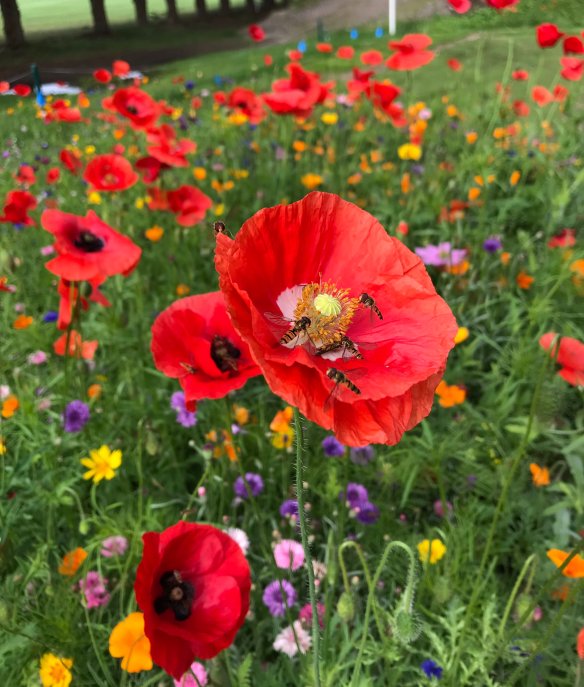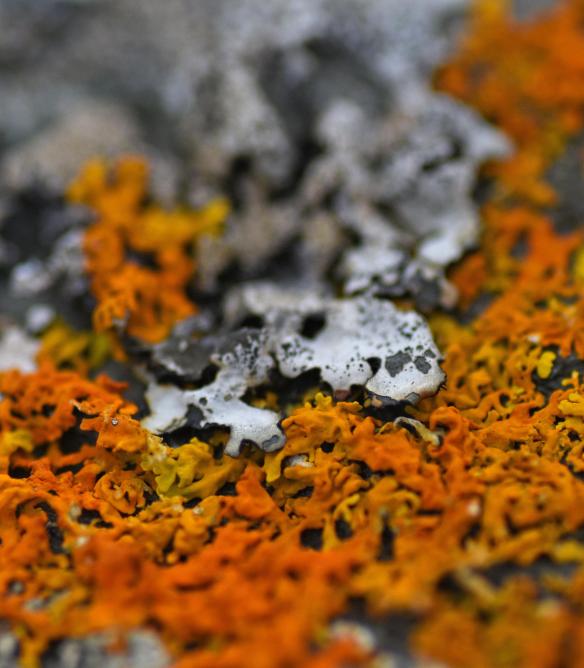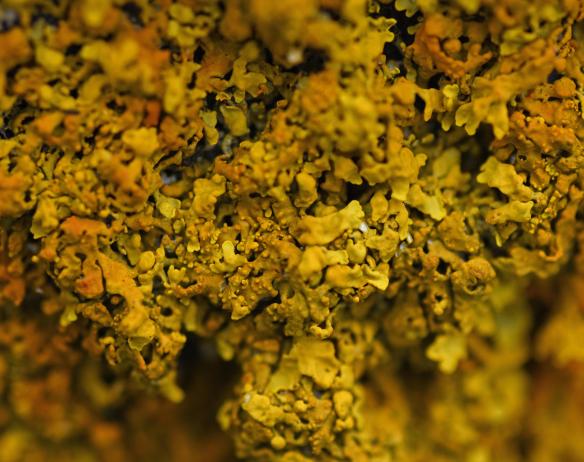Scotland has over 500 golf courses, and if those golf courses adopt pollinator-friendly approaches then it’s clear that we are onto a winner. In today’s blog we look at the potential for golf courses to help nature, and share a few suggestions.

Golf is played and watched by thousands of Scots. In early September the audience will be international as the Solheim Cup, the biggest event in women’s golf, takes place at Gleneagles. And there is increasing evidence that golf courses are realising that they can play a significant role in helping nature, and pollinators in particular.
What pollinators need is fairly straightforward – food and shelter. Flowers are crucial for our bees, hoverflies and butterflies, and a continual supply from early spring to late autumn is what keeps them going. Throw suitable sites for nesting and hibernating into the mix and you have a sound recipe to help our pollinators.
Golf courses, given their significant number and potential to act as vital parts of effective green corridors, suddenly begin to sound like a very attractive prospect when seeking to help our vital, but hard-pressed, pollinators.

Fortunately there are already many examples of golf course managers doing their bit for nature. Richard Mullen is one such example. The golf course manager at Banchory Golf Club in north-east Scotland, he leads by example.
Richard’s motto is ‘more than a golf course’, and a visit to his twitter account shows that he lives up to that motto. An array of beautiful images reveals wildflower meadows, bumblebees, red squirrels, swathes of butterflies and a suite of nesting sites for insects. These range from beehives, to bug hotels, and even include homes for carpenter bees (made by drilling into the large stacks of dead wood derived from essentials grounds maintenance).
In short Richard, whilst ensuring his course fulfils its primary purpose, is doing his bit to make excellent use of the fringes of his course for nature.

At first glance the image of a carefully manicured golf course suggests very lean pickings for pollinators. And it’s true that heavily managed billiard table greens and verdant fairways don’t offer much for nature, but step off the main playing areas and you can enter a different world. Richard’s approach has been to do just that.If the stars of the show are the small meadows for pollinators, then the areas around the club shop and car park are the innovative and practical cousins. And Richard uses those arrival areas to inform his golfing customers about the nature that is all around them.
Those hard landscape areas around buildings often have unfulfilled potential and can play a valuable role when they house containers, hanging baskets and window boxes. Persuading others of the value of what he is doing is a major step in spreading the word that our pollinators can be helped and enticing others to do their bit.
Competitions such as the Golf Environment Awards do their bit too and are to be applauded. This is a forum where the efforts of golf managers and greenkeepers to improve the ecology around their courses is acknowledged and rewarded. Winning a prize is always nice, but perhaps the true value of such competitions and events is their capacity to encourage the sharing of experience and ideas.
To have created one wildflower meadow would be great, so how then to sum up an effort that has seen the creation of FIVE wildflower meadows at Banchory? What’s more, Richard has linked up with local children to help with the planting, cleverly engaging the next generation in doing their bit for pollinators.
“My inspiration is based on the future but is very much based on the past,” notes Richard. “Going back to original methodology in producing fine turf has a knock on effect to nature, more than people realise, and being a custodian of the golf course we need to learn this … quickly.”
Banchory’s meadows thrive because the management is sympathetic to the long term survival of a range of plants. Leaving some areas uncut until autumn allows a long feeding window for pollinators, whilst removing the arisings annually reduces potential soil fertility. High soil fertility and a thriving meadow do not go hand in hand.

It’s worth dwelling too on the huge bonus that can be delivered to pollinators by delaying the first cut of grasslands until well into April. By doing so the chances are that vital early flowering food sources, such as dandelions, can provide that much needed spring boost for emerging pollinators, including queen bumblebees. Of course a little discretion in timings is essential, noting that between the north and south of Scotland there can be a notable difference in flowering periods.
When contemplating a meadow it is true that sowing commercially bought seed will be much more expensive than a ‘natural’ approach which relies on simply cutting the grass less often and allowing an area to do its ‘own thing’. That ‘thing’ would be helped by introducing yellow rattle which has a parasitic relationship with coarse (as opposed to course) grasses.
The boundary fringes of golf clubs present other opportunities. Here there could be hedgerows, trees and shrubs which will offer resources for pollinators and other insects. Native-flowering hedgerows are marvellous for pollinators and if only cut once every 3 or 4 years then they can provide a super home for wildlife and a vital food source. Likewise careful selection of bulbs – favouring the likes of snowdrop and crocus over tulips and daffodils – will be great news for pollinators.
Bunkers aren’t the only ‘traps’ on a golf course. Fertilisers are often used, and, depending upon gradient and layout, there can be an issue through run-off making adjacent areas too fertile for meadows to flourish. However, by noting how the management of fairways and greens impacts on these adjacent areas, an accurate picture of which plants might prosper can be gradually compiled.
The creation of good habitat for pollinators isn’t the end of the line for Richard. Next up he is striving to get help to compile a reliable species list for his course. Knowing what insects are on site will inform Richard’s direction and decisions around a range of issues such as what sort of nesting opportunities he provides, and what he plants.
So a pollinator ‘Masters’ Green Jacket for Richard, and a call to other golf clubs to follow suit. Indeed if your golf club is doing its bit for pollinators we would love to hear from you with a view to spreading more good news and sharing good practice.

Further reading:
Our colleagues behind the All Ireland Pollinator Plan have produced some excellent guidance ‘How to make Golf Courses pollinator friendly. You can find the link here.
Follow Richard on twitter at https://twitter.com/BGCagronomy
The Golf Environment Organisation Foundation (which is based in Scotland) is the international non-profit organisation dedicated entirely to providing a practical sustainability system for golf. Banchory is one of a growing number of clubs in Scotland and around the world that has joined the new OnCourse® programme for sustainable golf course and club management, and not only that, but has taken the extra step to become fully GEO Certified®, an ecolabel just for golf that is golf’s equivalent of the FSC, Rainforest Alliance, MSC and Fairtrade labels.



 One of the highlights in June was spotting a Beautiful Demoiselle on the very day we had a Damsel and Dragon event with the exceptionally knowledgeable Pat Batty. I’m going to miss these wee hairy faces till they appear again next April, and what a joy it will be to spot the first of the year.
One of the highlights in June was spotting a Beautiful Demoiselle on the very day we had a Damsel and Dragon event with the exceptionally knowledgeable Pat Batty. I’m going to miss these wee hairy faces till they appear again next April, and what a joy it will be to spot the first of the year.



 So, come along, please do stand and stare and open your eyes to the small things – I find it helps to put the big things in perspective.
So, come along, please do stand and stare and open your eyes to the small things – I find it helps to put the big things in perspective.


















